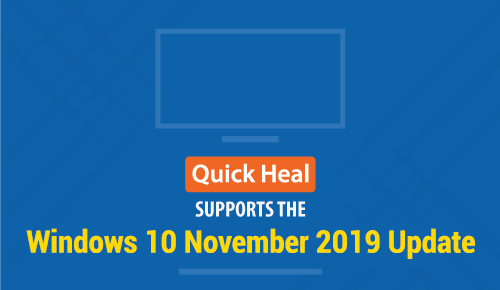Quick Heal Supports Windows 10 November 2019 Update

Microsoft has recently come up with a new update for Windows 10 PCs, called Windows 10 November 2019 Update (Build Version 1909).
Here we’ll list down some of the highlights of this update and see how Quick Heal is compatible with this OS.
Highlights of Windows 10 November 2019 Update
- Enhanced Microsoft Edge web browser experience.
- Introduction of a new button “Manage notifications” to the top of Action Center that launches the main “Notifications & actions” Settings page. The new “Reserved Storage” feature through which, some disk space will be reserved to be used for updates, apps, temporary files, and system caches, to ensure that critical OS functions always have access to disk space.
- Notifications settings under Settings > System > Notifications will now default to sorting senders of notification by most recently shown notification, rather than senders’ names. This makes it easier to find and configure frequent and recent senders. A new setting is also available to turn off notification alert tune.
- The navigation pane on the Start menu now expands when you hover over it, to let you know where the click action may lead you.
- Options to configure and turn off notifications from an app/website are also shown right on the notification, both as a banner and in Action Center.
- Added the ability for Narrator and other assistive technologies to read and learn where the Fn (function) key is located on the keyboard and what its current status is, locked or unlocked.
- Updated the search box in File Explorer powered by Windows Search. This change will help integrate OneDrive content online with the traditional indexed results.
- Enabled the ability for enterprises to supplement Windows 10 in Secure Mode policy to allow traditional Win32 (desktop) apps from Microsoft Intune.
- Enabled Windows Defender Credential Guard for ARM64 devices, for additional protection against credential theft for enterprises deploying ARM64 devices in the organizations.
Supported Quick Heal Version Details
1. For Existing Users
Users having Quick Heal version 16.00 or later must take the latest Quick Heal Updates on Windows 10 19H1 first. Then they can upgrade Windows operating system (OS) to Windows 10 19H2. As Windows 10 19H2 is an update package and should be installed on top of Windows 10 19H1.
Recommendation – After receiving the latest Quick Heal Updates, restart your PC. Then migrate to Windows 10 19H2.
2. For New Users
Fresh Install – Our latest version Quick Heal Product v18.00 is compatible with Windows 10 November 2019 Update.
You must download the latest version of Quick Heal product from https://www.quickheal.com/quick-heal-product-installer
How to apply the latest Quick Heal Update?
- The update will be applied automatically if Automatic Update in Quick Heal is turned ON.
- You can also apply the update manually, by following any one of these methods:
- On the dashboard of Quick Heal, click the Update Now
- Go to Help > About and click Update Now.
- Right-click on the Quick Heal icon in the system tray and click Update Now.
- Go to Start > All Programs > Quick Heal and click Quick Update.
How to ensure if the Quick Heal update has been successfully installed and is compatible with Windows 10 November 2019 Update?
If your Quick Heal Virus Database Date is latest, it means it is compatible with Windows 10 19H2.
Note: Fresh installation of Quick Heal 16.00 or earlier version is not supported on Windows 10 19H2.
If you have any queries about Windows 10 19H2 and Quick Heal product, please call us on 1800-121-7377 or drop us a message in the comments section below.
No Comments, Be The First!